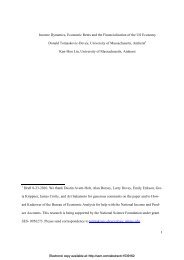Corporate governance and firm valuation
Corporate governance and firm valuation
Corporate governance and firm valuation
Create successful ePaper yourself
Turn your PDF publications into a flip-book with our unique Google optimized e-Paper software.
410 L.D. Brown, M.L. Caylor / Journal of Accounting <strong>and</strong> Public Policy 25 (2006) 409–434<br />
equity prices. Journal of Finance 60, 2859–2894]. We create Gov-Score, a summary <strong>governance</strong><br />
measure based on 51 <strong>firm</strong>-specific provisions representing both internal <strong>and</strong><br />
external <strong>governance</strong>, <strong>and</strong> we show that a parsimonious index based on seven provisions<br />
underlying Gov-Score fully drives the relation between Gov-Score <strong>and</strong> <strong>firm</strong> value. Our<br />
results support the Bebchuk et al. (2005) findings that only a small subset of provisions<br />
marketed by corporate <strong>governance</strong> data providers are related to <strong>firm</strong> <strong>valuation</strong>, <strong>and</strong> the<br />
Cremers <strong>and</strong> Nair (2005) evidence that both internal <strong>and</strong> external <strong>governance</strong> are linked<br />
to <strong>firm</strong> value. The 51 <strong>governance</strong> provisions we consider include five that are relevant to<br />
accounting <strong>and</strong> public policy: stock option expensing, <strong>and</strong> four that are audit-related. We<br />
find none of these five measures to be related to <strong>firm</strong> <strong>valuation</strong>. We document that only<br />
one of the seven <strong>governance</strong> provisions important for <strong>firm</strong> <strong>valuation</strong> was m<strong>and</strong>ated by<br />
either the Sarbanes–Oxley Act of 2002 or the three major US stock exchanges. We provide<br />
researchers with an alternative measure of <strong>governance</strong> to G-Index with three distinct<br />
advantages: (1) broader in scope of <strong>governance</strong>, (2) covers more <strong>firm</strong>s, <strong>and</strong> (3) more<br />
dynamic, reflecting recent changes in the corporate <strong>governance</strong> environment.<br />
Ó 2006 Elsevier Inc. All rights reserved.<br />
Keywords: <strong>Corporate</strong> <strong>governance</strong>; Firm <strong>valuation</strong>; Anti-takeover; Internal <strong>and</strong> external <strong>governance</strong><br />
1. Introduction<br />
<strong>Corporate</strong> <strong>governance</strong> has recently received much attention due to high profile<br />
sc<strong>and</strong>als such as Adelphia, Enron <strong>and</strong> WorldCom, serving as the impetus to the<br />
Sarbanes–Oxley Act of 2002, the most sweeping corporate <strong>governance</strong> regulation<br />
in the US in the last 70 years (Byrnes et al., 2003). Consistent with this focus on<br />
corporate <strong>governance</strong>, data providers have arisen to advise <strong>firm</strong>s on <strong>governance</strong><br />
matters <strong>and</strong> evaluate the strength of their corporate <strong>governance</strong>. Prior studies<br />
have used the 24-factor Investor Responsibility Research Center (IRRC) database<br />
as a proxy for corporate <strong>governance</strong>, <strong>and</strong> have found that better <strong>governance</strong><br />
is related to higher <strong>firm</strong> <strong>valuation</strong> as proxied by Tobin’s Q (Gompers et al., 2003;<br />
Bebchuk <strong>and</strong> Cohen, 2005; Bebchuk et al., 2005; Cremers <strong>and</strong> Nair, 2005). 1 Bebchuk<br />
et al. (2005) create an entrenchment index based on six factors underlying<br />
G-Index, <strong>and</strong> document that their parsimonious index fully drives the Gompers<br />
et al. (2003) <strong>valuation</strong> results. However, studies using IRRC data can only examine<br />
the effects of external <strong>governance</strong> in spite of the fact that effective corporate<br />
<strong>governance</strong> requires both internal <strong>and</strong> external measures (Cremers <strong>and</strong> Nair,<br />
2005). Cremers <strong>and</strong> Nair (2005) use shareholder activism to proxy for internal<br />
corporate <strong>governance</strong>. However, their study does not examine which internal<br />
<strong>governance</strong> provisions, if any, matter for <strong>firm</strong> <strong>valuation</strong> purposes. 2 We fill this<br />
1<br />
There are 28 IRRC factors but Gompers et al. (2003) combine <strong>firm</strong>-level factors with state law<br />
factor analogues to form their 24-factor G-Index.<br />
2<br />
Holmstrom <strong>and</strong> Kaplan (2001) argue that anti-takeover measures are less important in recent<br />
years for disciplining managerial behavior.







